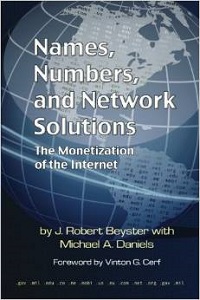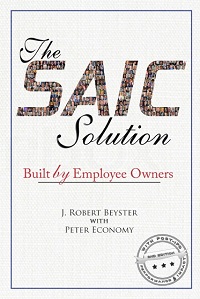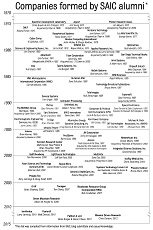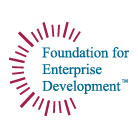Here we are again — like Arnold, we’re back. As you can imagine, the last month has been a busy one for us. Peter Economy, Mary Ann Beyster, and I have all been working hard on finishing the book and getting it to the publisher. The final manuscript was mailed out to the publisher Monday, and the book will be published March 16. I had not realized what publishing a book would entail. It’s not just writing the book, it’s finding endorsements and much more. We have a good list of endorsers, including Bill Perry, Richard Atkinson, Mel Laird, Bobby Inman, Harold Agnew, Tony Tether, Joseph Blasi, Richard Freeman, and Frances Hesselbein . In addition, William Taylor — the co-founder of Fast Company magazine, and the keynote speaker for the upcoming Beyster Institute/NCEO 2007 Employee Ownership national conference — has written the foreword for the book.
We secured a publicist — Meryl Moss, in Westport , Connecticut — and her team has started a nationwide PR campaign for the book. Dan Peoples in San Diego is helping us with interviews, articles, and other reporter requests. We plan to have a number of book signings, including at the Beyster Institute/NCEO conference here in San Diego on March 21 starting around 5:30 pm, and at Warwick’s in La Jolla on April 19 starting at 7:30 pm. We also plan to have other signings in the San Diego and Washington DC area after the book is published. I’ll let you know when and where on events as we get them set up. If you’d like a signed copy of the book but can’t get to one of the signing events, you’ll be able to order one directly from the FED web site (starting in February). More information will follow.
I’m still trying to decide whether I would recommend writing books to my thousand closest friends. Maybe time will tell.
Click on the comments link to share your thoughts.
- Bob
Here are my responses to previous weeks’ comments:
Andy Laidig (Week 30): Thank you for contacting me. It’s always great to hear when one of our alumni has successfully established a new company. Health care is a very challenging area right now. It needs access to the brainpower of experienced engineers and scientists to solve the many problems. It sounds like your company is employee owned, which would please me. I would enjoy seeing a brochure of what you do. Best wishes for the future.
Ed Rumble (Week 30): Since replying to you in December, I have become aware of the activity of NuStart toward building new nuclear facilities. Thanks for sending me this extensive list of new activity. I had not realized that there are so many organizations interested in nuclear power. What I’ve been worried about is that the inability of the United States to finish Yucca Flats would discourage this activity. I don’t know what the industry plans to do about the disposal of nuclear waste. Please tell me if you know.
Gael Tarleton (Week 30): Thank you for starting the three new initiatives that you described in your posting. I see that you are still interested in what is going on in Russia and playing a role in trying to help. I suspect that you are discussing entrepreneurial activities with them. I will mention to Mary Ann Beyster your activities and she may want to join you in some of the discussion groups — especially the one on professional opportunities for women. On the third initiative, I would appreciate if you would keep us abreast of the work you are doing on the roundtable for nuclear security interests. You may well have some new ideas that others would like to hear about.
Carl Bloemker (Week 29): Please forgive me for taking so long to reply to your blog comments. We have been finishing the book on SAIC, and now that we are done, I can get back to you. I’m curious what you are doing these days. I suspect you are still living in Albuquerque and I hope you are still working with the Weapons Lab on interesting and challenging problems. I look forward to hearing from you.
Chris Smith (Week 28): Regarding whether I believe it’s easier to inculcate the principles of entrepreneurship and employee ownership in smaller or mid-size organizations: Yes, I do — absolutely. The culture is not usually well-established in smaller companies. They are also searching for something that will make them unique, so it’s often more appealing for them to use entrepreneurship and employee ownership as a rallying point. In larger organizations — certainly if it’s a public corporation — the method of operation and the culture is usually well-established and it’s harder to sell the employee ownership notion. Finances have been thought out and sales organizations have been established, so there is less motivation to do it. The only thing that can change this is if a new CEO comes in with a strong motivation to inject one or both of these concepts into the organization based on past experience. Regarding the impact of M&A consolidation, yes, a great amount of M&A activity would bring about a decline in entrepreneurial activity. The question is: Why? I think that the management of the companies involved gets very consumed by the M&A process. This leads to growth, but it also can diminish the pressure to grow through other avenues, including entrepreneurship and employee ownership. I agree that a bureaucratic culture suppresses individual motivation.





Dr. Beyster,
Thank you very much for your January 25 response and here is a follow-up summary on nuclear waste.
Progress on the key issue of a national repository for spent fuel and high level waste storage presently stored in 126 sites around the country continues to be disappointing and the outcome uncertain. Utilities have added dry cask storage onsite and new plants are to have provisions for 60 years of dry storage in addition to wet storage.
The option of using Indian sites appears to be exhausted. A key effort by a group of utilities to store the waste on Indian reservations was started in 1996 through Private Fuel Storage, LLC (PFS) to develop a private, centralized dry storage facility on the 18,000 acre Skull Valley Indian Reservation, approximately 45 miles southwest of Salt Lake City. In 2005, the NRC granted PFS a construction and operating license. However in early 2006, Senator Reid and others were able to pass legislation that would effectively block transportation routes to the proposed site.
DOE, which signed contracts with nuclear utilities to begin accepting spent fuel in early 1998, is working on the license application for the Yucca Mountain Repository. They presently plan to submit it in mid-2008, which they indicate might lead to a 2017 opening. DOE has also recently initiated Global Nuclear Energy Partnership (GNEP) that includes an effort to re-look at recycling spent fuel. This is a long term effort. In the late 1990s, DOE requested, but Congress did not give them the authority to develop a temporary storage facility.
In summary, spent fuel will continued to be stored at plant sites around the nation and DOE’s efforts may slow down further, given the 2006 congressional election results.
Sincerely,
Ed Rumble
If you are coming to the SF Bay area to promote the book, would love to see you! I also would take advantage of you to see if you could address either the Women Presidents Organization or the CEOAlliance. The great story of SAIC, keeping the nimble small company culture in a continuing larger corporation would have appeal. Cheers to you. Ceil McCloy
Dr Beyster
Current I am working for L-3 Com and I am involved in two areas. Space Defense and High Power Microwave weapons. Probably will work with Dishon on a concept we both have.
I am also coaching soccer at a local high school.
Hope you are doing well. I will get a copy of your book and mail it to you for you autograph.
The best time in my professional career was working for you.
Carl Bloemker
Carl: Good to hear from you. I’m glad you’re doing well at L-3 Communications. I suppose you remember Gene Ray who left SAIC and founded Titan Systems, which was later bought by L-3. He has become a good friend of mine and we often work on panels together. You and John Dischon are capable of creating very innovative technical concepts. I am sure you will do well at L-3, as you did at SAIC. I miss the good times we had together. If you see Jim Kramer tell him “hello” for me. In the meantime, if you see corrections or additions for the book, please let me know as we are in a constant process of updating the text. If I’m ever in Albuquerque for a book signing, I will certainly look you up. Albuquerque in the summertime is no picnic.